How to become a fitness model in 2024?
A fitness model is a professional who earns money by promoting fitness-related products & services, including athletic clothing, supplements & gym memberships.
Ever caught yourself scrolling through Insta, admiring all those fitness models, and thought, "Hey, I could totally be one of them"? Well, it's time to stop dreaming and start doing, because 2024 is YOUR year to shine in the fitness modeling world!
Fitness modeling isn't just about flaunting a ripped bod—it's about heart, hustle, and a hefty dose of smarts. The fitness industry is exploding this year, and there's a massive crowd cheering for fresh faces like yours to step onto the scene.
Think about it: not only do you get to promote health and wellness, but you also become the face that inspires millions to keep fit and stay healthy.
Ready for the insider scoop on transforming those fitness dreams into glossy magazine covers? Whether you're a gym rat or just starting to flex those muscles, we’re here to guide you every step of the way.
Well buckle up, because we’re about to embark on an epic journey to get you runway (or, should we say, treadmill?) ready!
Step 1: Understanding the fitness modeling industry
Alright, let’s kick things off with the basics: understanding the fitness modeling industry. You might think it’s all about having a killer six-pack and a sparkling smile, but there’s a lot more to it than that. Knowing the different types of fitness modeling and what’s expected of you can make all the difference. Let’s break it down.
Different types of fitness modeling

Source: Pexels
1. Commercial Fitness Modeling
This is where you see models in advertisements, fitness magazines, and online campaigns for brands. Think Nike ads, protein powder promotions, and those inspiring workout videos. These gigs often require you to have a versatile look and be able to portray a healthy, active lifestyle.
2. Competitive Fitness Modeling
Ever seen those bodybuilding and fitness competitions? That’s competitive fitness modeling. It’s all about showcasing your physique, muscle definition, and overall fitness level. This path often requires intense training and a strict diet to be stage-ready.
3. Social Media Fitness Influencing
In the age of Instagram and TikTok, social media fitness models are a big deal. These influencers build their brand by sharing workout routines, diet tips, and snippets of their fitness journey. It’s a great way to connect directly with an audience and build a personal brand.

Source: Freepik
Key requirements and expectations
Becoming a fitness model isn't just about looking good—there's a lot more that goes into it. Here are the key requirements and expectations you need to meet to make it in the fitness modeling world:
1. Physical fitness and appearance standards
Balanced physique: You need to maintain a well-proportioned and toned body. This means not just bulking up on muscle but also ensuring your overall physique is symmetrical and aesthetically pleasing. Think broad shoulders, a narrow waist, and well-defined muscles.
Healthy skin and hair: Your skin and hair need to look healthy and vibrant. This often means having a skincare routine that keeps your skin clear and glowing, as well as hair care that ensures your locks are shiny and strong. Hydration, proper nutrition, and good hygiene are essential. We recommend you try castor oil for hair to keep your hair shiny and healthy.
Flexibility and endurance: Fitness modeling often involves dynamic poses and activities. You'll need to be flexible and have good stamina to keep up with long shoots and multiple takes. Regular stretching, yoga, and endurance training can help you stay limber and energetic.
Consistent workout routine: Regular exercise is non-negotiable. You'll need a workout routine that includes strength training, cardio, and flexibility exercises. This not only helps you stay in shape but also prepares you for physically demanding shoots.
Diet and nutrition: A balanced diet is crucial for maintaining your physique and overall health. This usually involves eating plenty of lean proteins, whole grains, fruits, and vegetables, and avoiding processed foods and sugars. Many fitness models also work with nutritionists to fine-tune their diet.
2. Physical fitness and appearance standards
Holistic wellness: In 2024, there's a huge emphasis on holistic wellness. According to McKinsey, there’s an increased focus on mental health and holistic wellness in the fitness industry. Brands and audiences are looking for models who not only look fit but also embody a healthy, balanced lifestyle.
This includes mental health, stress management, and overall well-being. Practicing mindfulness, getting adequate sleep, and maintaining a positive mental outlook are key.
Sustainability: Sustainability is more important than ever. As noted by Global Wellness Institute, sustainability continues to be a significant trend in the wellness sector. Fitness brands are increasingly looking for models who promote eco-friendly practices, such as using sustainable workout gear and supporting brands with green initiatives.
Being knowledgeable about sustainability and integrating it into your personal brand can set you apart.
Body positivity and inclusivity: The industry is shifting towards a more inclusive and body-positive approach. Forbes highlights that inclusivity and body positivity are becoming crucial elements in the fitness world.
Fitness models are expected to celebrate diversity and promote self-love. This means being open about your fitness journey, including the ups and downs, and supporting others in their own journeys.
Digital savvy: In the age of social media, being digitally savvy is a must. Brands are looking for models who can engage with their audience online, create compelling content, and have a strong social media presence.
Understanding the latest social media trends and algorithms will help you grow your following and attract potential clients. Social media trends continue to evolve, and staying updated can greatly benefit your fitness modeling career.
Professionalism and work ethic: Finally, professionalism is crucial. This means showing up on time for shoots, being prepared and easy to work with, and consistently delivering your best performance. A strong work ethic and a positive attitude can make a lasting impression and lead to more opportunities.
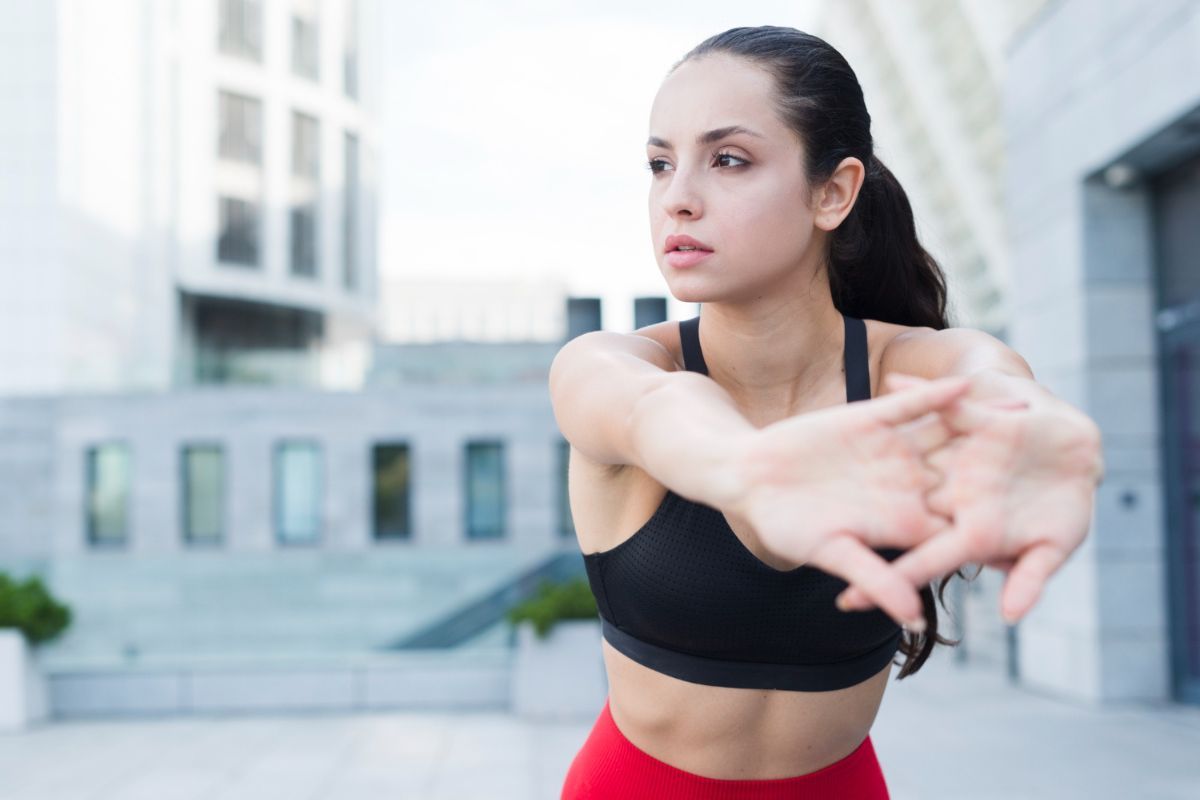
Source: Freepik
Step 2: Build your fitness foundation
Alright, it's time to get down to the nitty-gritty—building that rock-solid fitness foundation. This step is all about creating and maintaining the physical condition necessary to shine as a fitness model. Let’s break it down into manageable parts so you can start sculpting the best version of yourself.
Develop a consistent workout routine
Importance of regular exercise:
Consistency is key in fitness modeling. It’s not just about working out hard but doing it regularly. Aim for at least 5-6 days a week of exercise, mixing different types of workouts to keep your body challenged and balanced.
Targeted workouts:
Your workout routine should focus on both strength and cardio. Strength training helps build and tone muscles, giving you that defined look. Incorporate exercises like squats, deadlifts, bench presses, and rows.
For cardio, mix high-intensity interval training (HIIT) with steady-state cardio to keep your heart healthy and burn fat efficiently.
Example workout plans:
- Strength training split:
- Day 1: Upper Body (Chest, Back)
- Day 2: Lower Body (Legs, Glutes)
- Day 3: Rest or Active Recovery (light yoga, walking)
- Day 4: Arms and Shoulders
- Day 5: Full Body
- Day 6: HIIT Cardio
- Day 7: Rest or Light Cardio
- Weekly schedule:
- Monday: Chest and Back
- Tuesday: Legs and Glutes
- Wednesday: Active Recovery (Yoga)
- Thursday: Arms and Shoulders
- Friday: Full Body Workout
- Saturday: HIIT Cardio
- Sunday: Rest
Maintain a balanced diet
Nutritional guidelines: A balanced diet is your best friend in fitness modeling. Fuel your body with the right nutrients to support your workout routine and overall health. Focus on whole foods—lean proteins, complex carbs, healthy fats, and plenty of fruits and vegetables.
Tips for meal planning: Plan your meals ahead of time to ensure you're eating a balanced diet. Include a source of protein in every meal to help build and repair muscles.
Don’t forget your complex carbs like quinoa, brown rice, and sweet potatoes to provide energy for those intense workouts. Healthy fats from avocados, nuts, and olive oil are essential for overall health.
Supplements: While whole foods should be your primary source of nutrition, supplements can help fill any gaps. Consider protein powder for post-workout recovery, BCAAs to reduce muscle soreness, and multivitamins to ensure you’re getting all the necessary nutrients.
Tips for meal planning and supplements
Meal prep: Take time each week to prep your meals. This not only saves time but also helps you stick to your nutritional goals. Cook in bulk, portion your meals, and store them in the fridge or freezer. Having healthy meals ready to go can prevent you from reaching for unhealthy options when you’re hungry.
Hydration: Stay hydrated! Drinking enough water is crucial for overall health and performance. Aim for at least 8-10 glasses of water a day, more if you’re working out intensely or in a hot climate.
Tracking progress: Keep track of your workouts and meals. This can help you see what’s working and where you might need to make adjustments. Apps like MyFitnessPal or a simple fitness journal can be great tools.
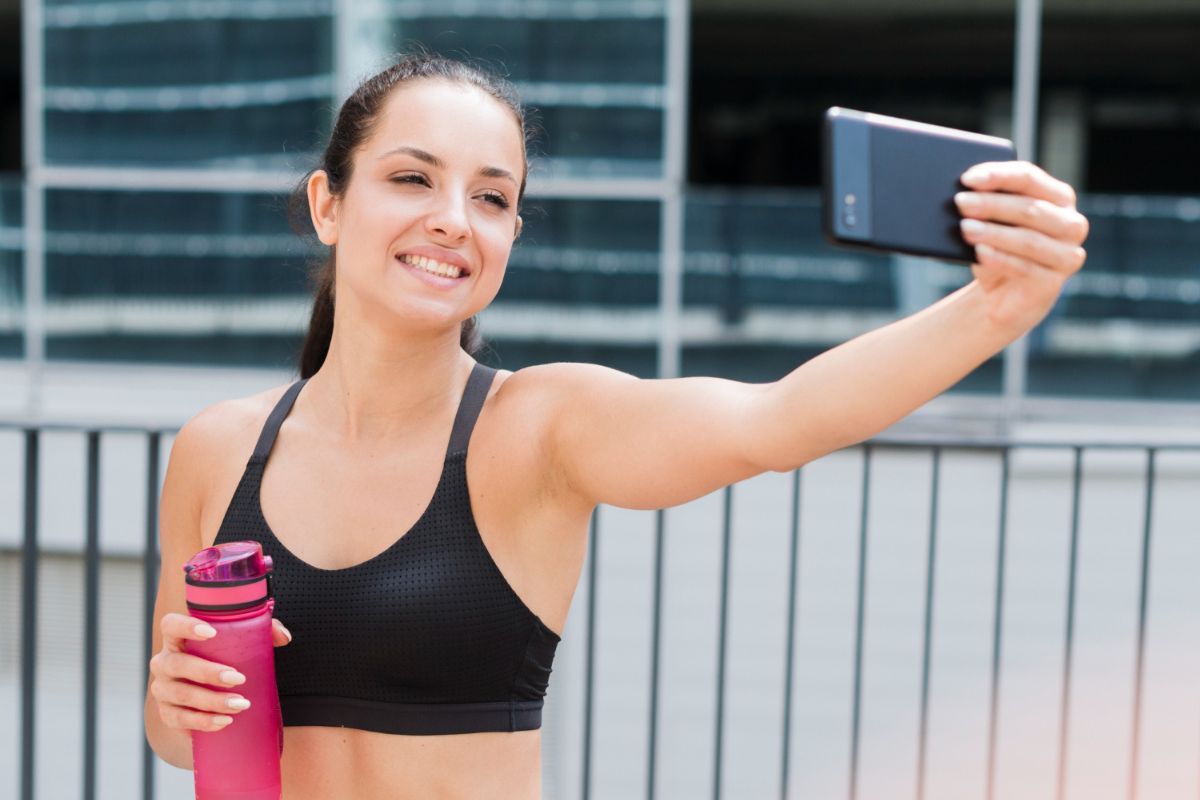
Source: Freepik
Step 3: Create a personal brand
Now that you’re building a rock-solid fitness foundation, it’s time to focus on something just as important—your personal brand. In the world of fitness modeling, your brand is what sets you apart and makes you memorable.
It’s how you present yourself to the world and connect with your audience. Let's dive into how to create a standout personal brand.
Define your unique style and niche
Identify what sets you apart: First things first—what makes you unique? Maybe it’s your incredible flexibility, your motivational story, or your expertise in a specific fitness area like yoga, bodybuilding, or functional training. Identify your strengths and what you can offer that others might not.
Selecting your niche market: Find your niche within the fitness industry. Are you aiming to inspire beginners with easy-to-follow workouts, or are you more about hardcore training for advanced athletes?
Do you focus on sustainable fitness, body positivity, or a specific type of exercise like pilates or CrossFit? Defining your niche helps you target the right audience and become an authority in that area.
Build an online presence
Importance of social media and personal websites: In today’s digital age, having a strong online presence is crucial. Social media platforms like Instagram, TikTok, and YouTube are where fitness models showcase their work, connect with followers, and attract brands.
A personal website can also serve as a professional portfolio where potential clients can see your work, read your blog, and contact you.
Tips for growing your online following:
- Consistency is key: Post regularly to keep your audience engaged. Create a content calendar to plan your posts in advance. Aim for a mix of workout videos, nutrition tips, personal stories, and motivational content.
- High-quality content: Invest in good equipment or work with a professional to ensure your photos and videos are high-quality. Clear, well-lit, and visually appealing content stands out and attracts more followers.
- Engage with your audience: Respond to comments, ask questions, and encourage your followers to share their progress. Engagement builds a loyal community and makes your followers feel valued.
- Collaborate with other influencers: Partnering with other fitness influencers can help you reach a wider audience. Look for collaboration opportunities like joint workouts, challenges, or shout-outs.
- Use relevant hashtags: Hashtags can help your content reach a larger audience. Use a mix of popular and niche-specific hashtags related to fitness, health, and wellness.
Showcase your skills and achievements
Photography and videography: A professional portfolio is essential for a fitness model. Work with a professional photographer or videographer to capture high-quality images and videos that showcase your physique, flexibility, and fitness skills. Include a variety of shots—action shots, posed photos, and lifestyle images.
Include competition results, certifications, and testimonials: Highlight your achievements in your portfolio. If you’ve competed in fitness competitions, include your results.
List any certifications you’ve earned, such as personal training or nutrition certifications. Testimonials from clients or brands you’ve worked with can also add credibility.
Highlight your unique fitness journey and story: Everyone loves a good story. Share your fitness journey—your challenges, triumphs, and what motivates you. Being authentic and relatable helps you connect with your audience on a deeper level.
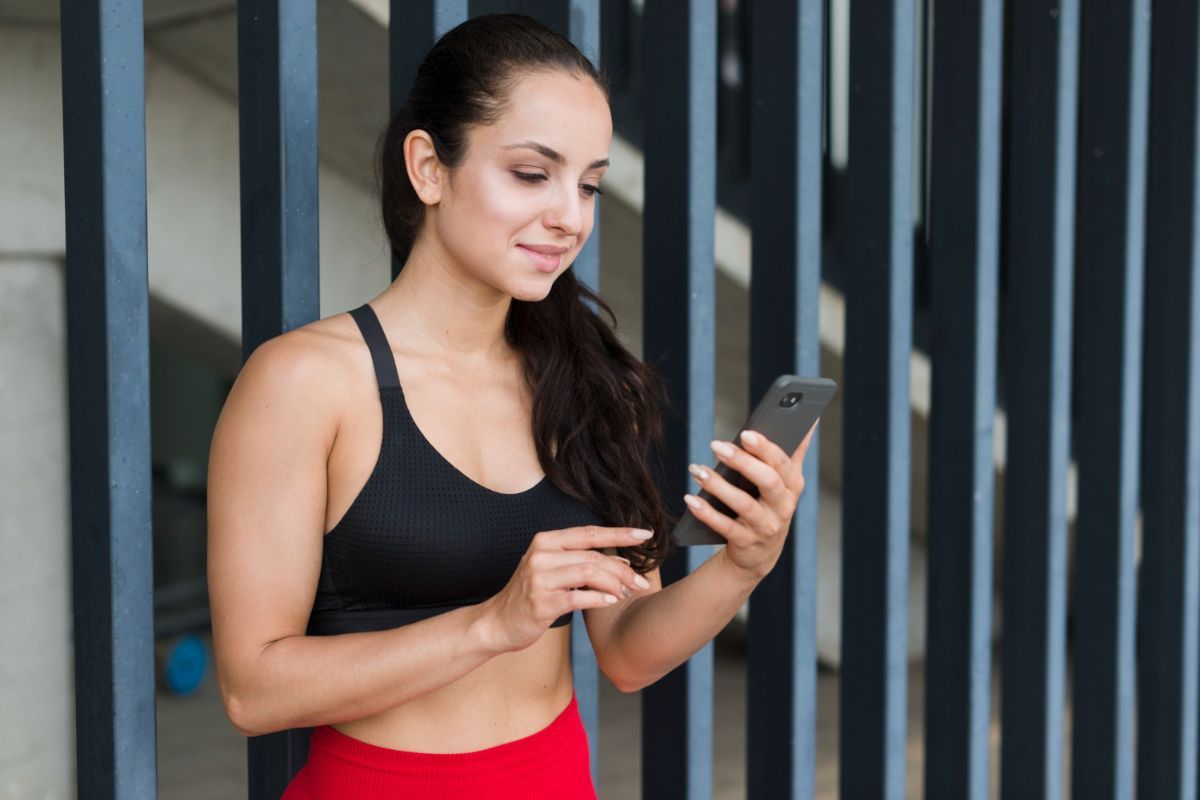
Source: Freepik
Step 4: Build a professional portfolio
Alright, you've laid the groundwork with your fitness foundation and personal brand. Now it's time to put it all together in a professional portfolio that will wow potential clients and agencies. Your portfolio is your visual resume, showcasing your skills, physique, and personality. Let’s break down how to create an impressive portfolio.
Photography and videography
Hire a professional photographer/videographer: Investing in a professional photographer or videographer is crucial. They have the expertise to capture you in the best light, angles, and settings. Look for someone with experience in fitness photography to ensure they understand how to highlight your physique effectively.
Types of photos and videos to include:
- Headshots: A clean, high-quality headshot is essential. This should capture your face clearly and show your personality. AI headshot generators can be a quick and effective solution to create polished, professional-looking images.
- Full-body shots: These should display your physique in various poses, showcasing your muscle definition and symmetry. Include both relaxed and flexed poses.
- Action shots: Capture you in motion, whether it’s lifting weights, running, or doing yoga. Action shots demonstrate your fitness abilities and energy.
- Lifestyle images: Show you in real-life settings, such as working out in the gym, running outdoors, or preparing healthy meals. Lifestyle shots give a glimpse into your daily life and fitness routine.
- Professional videos: Include short clips of you performing exercises, demonstrating techniques, or even a fitness routine. Videos are a dynamic way to showcase your skills and engage viewers.
Showcase your skills and achievements
Including competition results: If you’ve competed in fitness competitions, include your results. Highlight your achievements, such as placements, awards, or special recognitions. This shows your dedication and success in the fitness field.
Certifications and education: List any relevant certifications, such as personal training, nutrition, or specific fitness disciplines (e.g., yoga, pilates). Certifications add credibility and show your commitment to professional development.
Testimonials: Include testimonials from clients, trainers, or brands you’ve worked with. Positive feedback from others can significantly boost your credibility and attractiveness to potential clients.
Highlighting your unique fitness journey and story
Personal story: Share your fitness journey in your portfolio. This could be a brief biography that includes how you started, challenges you’ve overcome, and your goals. A compelling story can make you more relatable and memorable.
Transformation photos: If you have before-and-after photos that highlight your fitness transformation, include them. They’re powerful visuals that show your dedication and progress over time.
Blog or journal: Consider adding a blog or journal section to your portfolio where you share tips, workouts, or personal experiences. This adds depth to your portfolio and provides ongoing content to engage your audience.
Putting it all together
Create a professional website: Having a personal website is a great way to host your portfolio. It’s a central place where clients and agencies can learn about you, see your work, and get in touch. Use a clean, easy-to-navigate design.
Platforms like Wix, Squarespace, or WordPress offer user-friendly free templates that can make your site look professional.
Physical portfolio: While digital portfolios are essential, having a physical portfolio can be beneficial for in-person meetings or castings. Invest in a high-quality portfolio book that includes your best photos, achievements, and contact information.
Keep it updated: Regularly update your portfolio with new photos, videos, and achievements. This keeps it fresh and reflects your latest work and progress. Aim to refresh your portfolio every few months or whenever you have significant new content to add.
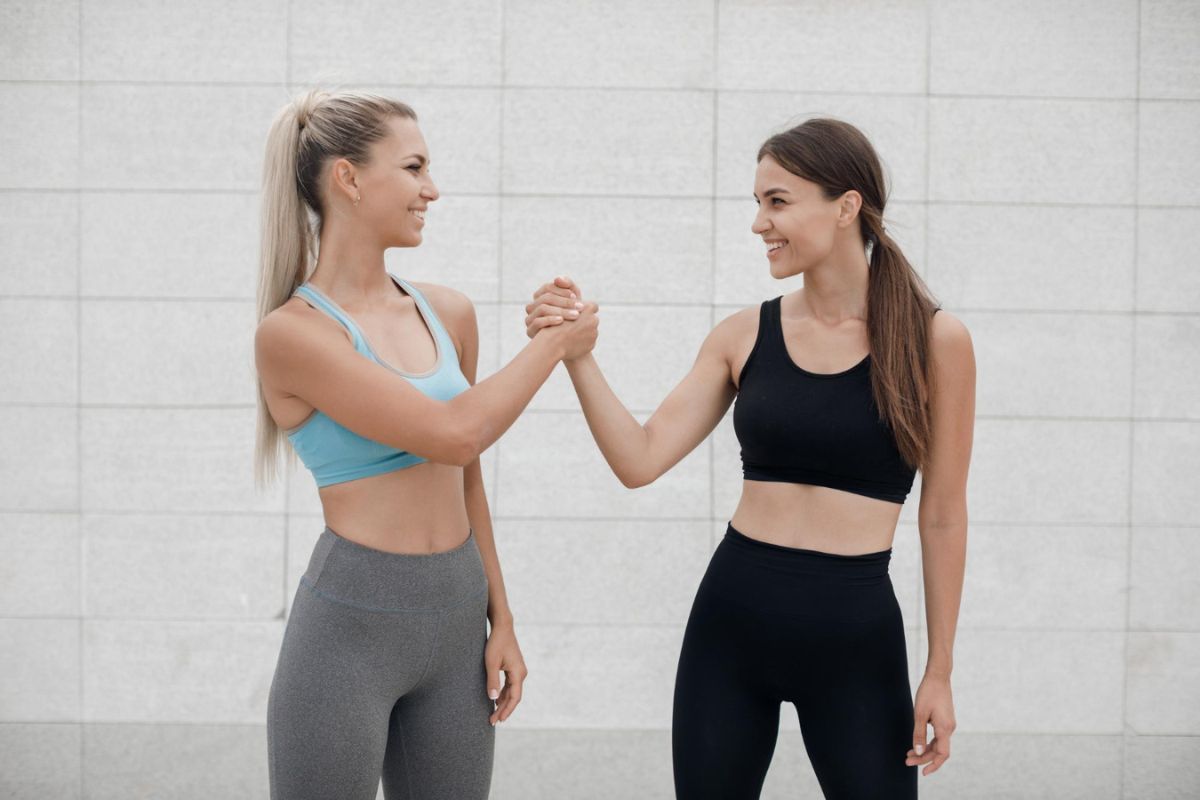
Source: Holiak on Freepik
Step 5: Network and make connections
Now that you have a strong fitness foundation, a personal brand, and a professional portfolio, it’s time to get yourself out there. Networking and making connections are crucial in the fitness modeling industry.
This step is all about building relationships, finding opportunities, and getting noticed. Let’s dive into how you can effectively network and make connections to boost your career.
Attend fitness events and competitions
Benefits of participating in industry events: Fitness events and competitions are gold mines for networking. They bring together industry professionals, brands, photographers, and other models. Attending these events can help you make valuable connections and stay updated on industry trends.
- Fitness expos and conventions: These events are packed with brands showcasing their products, fitness enthusiasts, and industry leaders. It’s a great place to meet potential clients, get inspired, and even land some gigs. Look for events like the Arnold Sports Festival or the Olympia Expo.
- Competitions: Whether you’re participating or attending, fitness competitions are excellent for networking. You’ll meet other competitors, judges, and industry insiders. Plus, showcasing your skills on stage can get you noticed by scouts and agencies.
How to make valuable connections:
- Be approachable: Smile, make eye contact, and be open to conversations. Networking is all about building relationships, so be friendly and approachable.
- Bring business cards: Always have business cards or a way to share your contact information easily. It’s a professional touch that makes it easy for people to reach out to you later.
- Follow up: After the event, follow up with the people you met. Send a friendly email or message, reminding them of your conversation and expressing your interest in staying connected.
Collaborate with other fitness professionals
Importance of networking with trainers, nutritionists, and other models: Collaborating with other fitness professionals can open up new opportunities and broaden your reach. Trainers, nutritionists, and other models can provide valuable insights, share their networks, and even refer you for gigs.
- Join fitness groups and communities: Online forums, social media groups, and local fitness communities are great places to connect with like-minded professionals. Participate actively, share your knowledge, and engage with others.
- Attend workshops and seminars: Educational events like workshops and seminars are not only great for learning but also for networking. You’ll meet professionals who are serious about their careers and willing to collaborate.
Tips for successful collaborations:
- Be professional: Always maintain professionalism in your interactions. Be reliable, respectful, and punctual when working with others.
- Showcase mutual benefits: When proposing collaborations, highlight the benefits for both parties. Whether it’s co-hosting a workout session, creating joint content, or sharing each other’s audiences, ensure it’s a win-win situation.
- Build genuine relationships: Networking is not just about taking—it’s about giving as well. Offer help, share opportunities, and support others. Genuine relationships can lead to long-term collaborations and friendships.
Utilize social media for networking
Engage with your audience: Your social media followers are part of your network. Engage with them by responding to comments, asking for their input, and sharing their stories. Building a community around your brand can lead to more significant opportunities.
- Reach out to influencers: Don’t hesitate to reach out to other influencers for shout-outs, collaborations, or advice. A simple DM or email can start a fruitful relationship.
- Participate in challenges and trends: Joining popular fitness challenges or trends can increase your visibility and connect you with others participating in the same activities.
Maintain a professional online presence: Your social media profiles are an extension of your personal brand. Keep them professional, positive, and aligned with your brand image. Consistency in your content and engagement will attract more followers and potential collaborators.
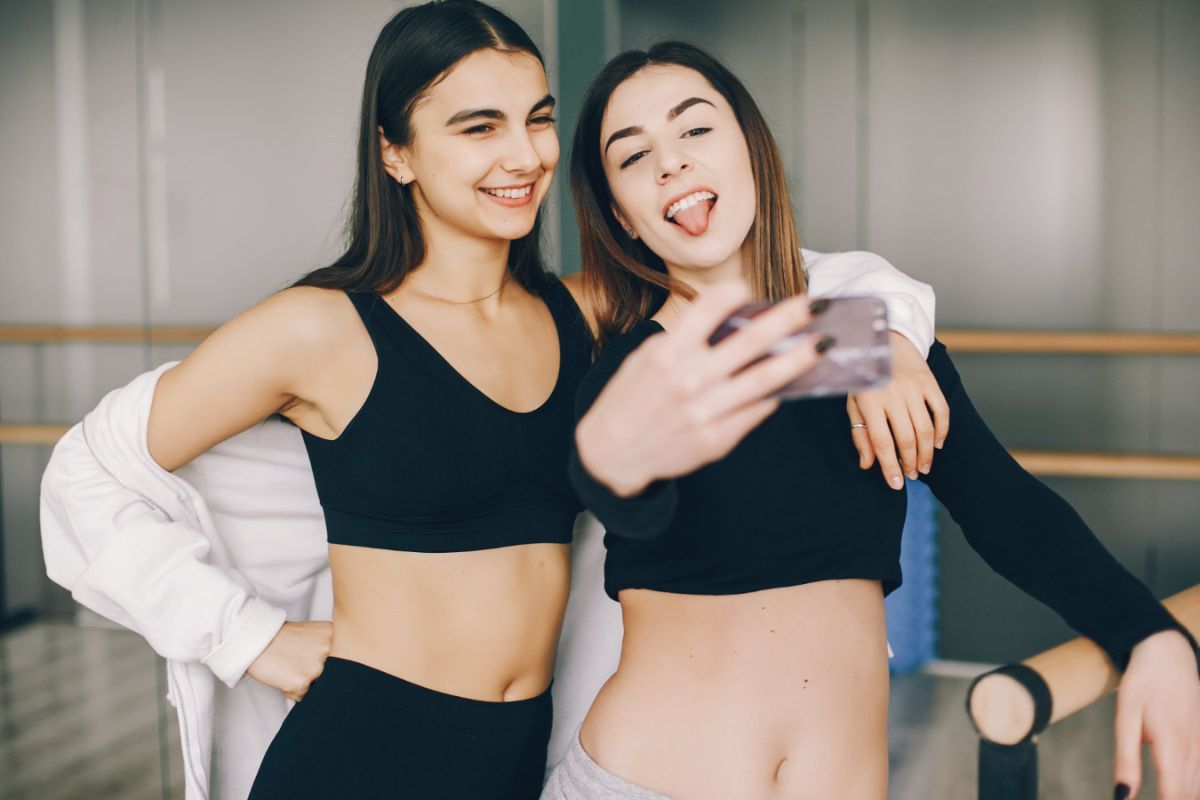
Source: prostooleh on Freepik
Step 6: Find representation
You've built a solid foundation, created a standout personal brand, compiled an impressive portfolio, and made valuable connections.
Now, it’s time to find representation. Having a modeling agency or a manager can open up more opportunities and provide professional guidance in your fitness modeling career. Here’s how to navigate this crucial step.
Research modeling agencies
Choosing the right agency: Finding the right agency is essential. Not all agencies are created equal, and it’s crucial to find one that aligns with your goals and values. Look for agencies that have a good reputation, specialize in fitness modeling, and have a track record of placing models in reputable gigs.
Top tips for research:
- Check online reviews and testimonials: Read reviews from other models to get a sense of the agency’s reputation. Websites like Model Mayhem or The Fashion Spot often have reviews and forums discussing various agencies.
- Look at their portfolio: Review the agency’s current roster of models and their work. This will give you an idea of the type of models they represent and the quality of jobs they secure.
- Network for recommendations: Use your connections to get recommendations. Ask other models, trainers, or industry professionals if they know of reputable agencies looking for new talent.
- Research their clients: Look into the brands and companies the agency works with. If they have a strong portfolio of reputable clients, it’s a good sign they can provide valuable opportunities.
Submit applications and attend castings
Preparing your application: When you find potential agencies, it’s time to submit your application. Make sure your submission stands out by including all the necessary materials and presenting yourself professionally.
What to include:
- Cover letter: Write a concise and compelling cover letter. Introduce yourself, explain why you’re interested in the agency, and highlight your unique attributes and achievements.
- Professional photos: Include a selection of your best photos from your portfolio. Ensure these photos showcase your physique, versatility, and personality.
- Resume: Prepare a resume that lists your experience, achievements, and relevant skills. Include any competitions, certifications, and notable collaborations.
- Links to social media: Provide links to your social media profiles, especially if you have a strong online presence. This gives the agency a broader view of your brand and reach.
Tips for succeeding in castings and auditions:
- Be prepared: Always come prepared with your portfolio, comp cards, and any required materials. Know the agency’s requirements and bring what’s necessary.
- Dress appropriately: Wear something that shows off your physique but is also professional. Typically, form-fitting athletic wear or simple, stylish clothing works well.
- Confidence is key: Walk in with confidence and a positive attitude. Agencies look for models who are not only physically fit but also confident and charismatic.
- Be professional: Arrive on time, be polite, and follow any instructions given. Professionalism goes a long way in making a good impression.
- Follow up: After the casting or audition, send a follow-up email thanking them for the opportunity. This shows professionalism and keeps you fresh in their minds.
What to expect after signing with an agency
Understanding the contract: If an agency offers you a contract, read it carefully. Understand the terms, including commission rates, exclusivity clauses, and any other commitments. Don’t hesitate to ask questions or seek legal advice if needed.
Building your career: Once signed, your agency will help you find jobs, negotiate contracts, and guide your career. Be proactive in communicating with your agent, expressing your goals, and seeking their advice.
Continued networking and development: Even with representation, continue networking and developing your skills. Attend industry events, stay updated with trends, and keep improving your fitness and modeling abilities.
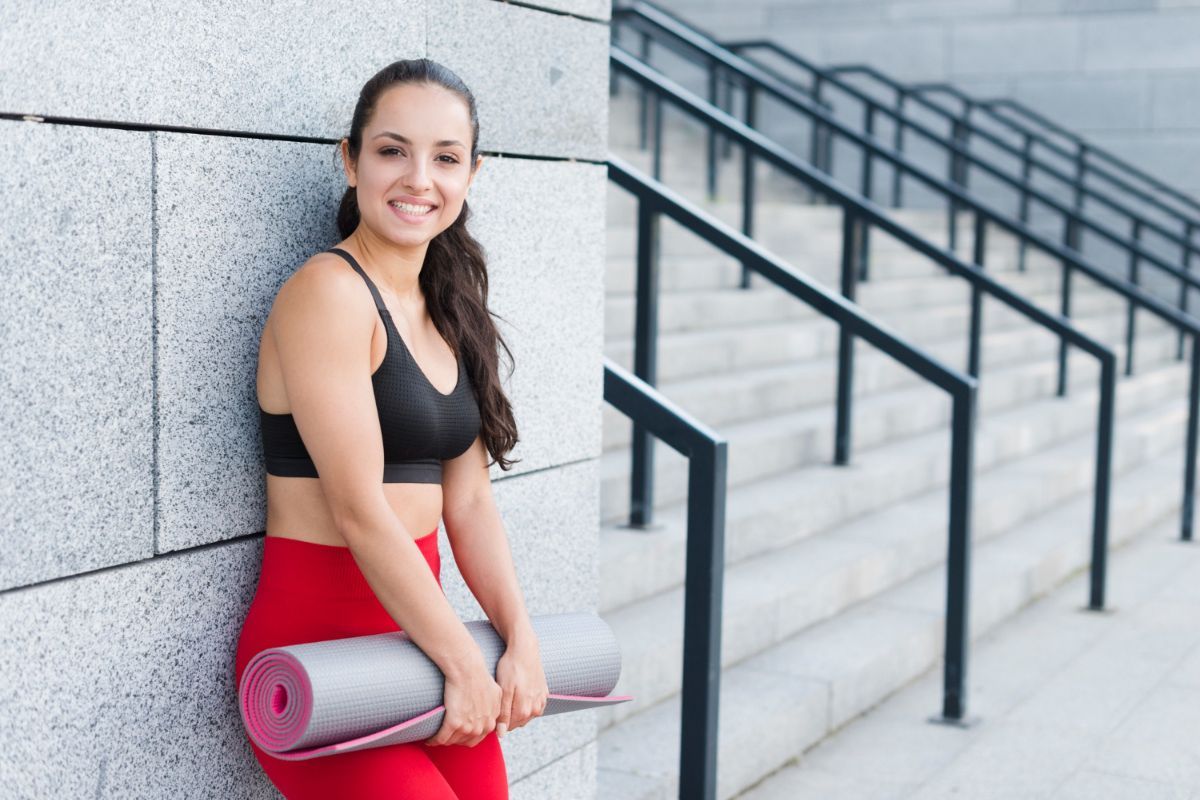
Source: Freepik
Step 7: Maintain your career
Congratulations! You've made it to the final step in your journey to becoming a fitness model. But the work doesn’t stop here.
Maintaining your career requires ongoing effort, continuous improvement, and the ability to handle the ups and downs that come with the industry. Here’s how to stay on top and keep your career thriving.
Continue improving your skills
Ongoing education and Training: The fitness industry is always evolving, and so should you. Keep learning and stay updated with the latest fitness trends, techniques, and science. This could mean taking new fitness classes, earning additional certifications, or even attending workshops and seminars.
- Stay certified: Keep your certifications up to date. Whether it's personal training, nutrition, or specialized fitness certifications, staying current shows your commitment to professionalism and expertise.
- Diversify your skills: Don’t limit yourself to one type of fitness. Explore different disciplines like yoga, pilates, HIIT, or strength training. The more versatile you are, the more opportunities you’ll have.
- Seek feedback: Regularly ask for feedback from photographers, trainers, and clients. Constructive criticism can help you identify areas for improvement and make you a better model.
Stay updated with industry trends: Fitness trends change rapidly. What’s popular today might not be tomorrow. Follow industry publications, blogs, and influencers to stay in the loop. Knowing what’s hot can help you align your brand with current trends and keep your content relevant.
Handle rejections and setbacks
Develop resilience: Rejection is part of the modeling world. Not every casting will be successful, and not every client will choose you. Developing a thick skin and resilience is crucial. Learn from rejections, but don’t let them deter you from your goals.
- Learn from experiences: Every experience, whether positive or negative, is a learning opportunity. Analyze what went well and what didn’t. Use this knowledge to improve and prepare for future opportunities.
- Stay positive: Keep a positive mindset. Surround yourself with supportive people who encourage you. Remember why you started and focus on your long-term goals.
Set realistic goals: Set both short-term and long-term goals for your career. This gives you direction and motivation. Celebrate your achievements along the way to keep yourself motivated.
Maintain a healthy lifestyle
Balanced diet and regular exercise: Maintaining your physique is crucial for your career. Continue to follow a balanced diet and regular exercise routine. Your health and fitness should always be a top priority.
- Avoid burnout: It’s easy to get caught up in the hustle, but overworking can lead to burnout. Listen to your body and take rest days when needed. Mental health is just as important as physical health.
- Mindfulness and stress management: Incorporate mindfulness practices like meditation or yoga into your routine. Managing stress effectively can improve your overall well-being and performance.
Regular health check-ups: Stay on top of your health with regular check-ups. This includes physicals, mental health check-ins, and any specific fitness-related assessments. Early detection of any issues can prevent bigger problems down the line.
Engage with your audience and stay relevant
Keep your content fresh: Your audience wants to see new and exciting content. Regularly update your social media with fresh photos, videos, and posts. Share your fitness journey, tips, workouts, and personal stories to keep your followers engaged.
- Interact with followers: Respond to comments and messages. Engaging with your followers builds a loyal community and increases your influence.
- Collaborate and network: Continue to collaborate with other fitness professionals and influencers. Networking should be an ongoing effort, not just something you do at the beginning of your career.
Adapt and Innovate: The digital landscape is constantly changing. Be willing to adapt and try new platforms or content formats. Whether it’s experimenting with new social media trends or creating a YouTube channel, staying innovative keeps your brand exciting.
Evaluate and adjust your strategy
Regular self-assessments: Periodically evaluate your career strategy. Are you meeting
your goals? Are there areas that need improvement? Self-assessment helps you stay aligned with your objectives and make necessary adjustments.
- Seek professional guidance: Consider working with a career coach or mentor who can provide objective feedback and advice. Their experience and insights can help you navigate your career more effectively.
- Stay financially savvy: Manage your finances wisely. Save and invest your earnings, and keep track of your expenses. Financial stability allows you to focus more on your career and less on monetary concerns.
Conclusion
Congrats, you've made it through this ultimate guide to becoming a fitness model in 2024! From figuring out the fitness modeling scene and building a killer fitness routine to creating your unique brand, networking like a pro, and finding the perfect representation, you’re now ready to take on the world.
Fitness modeling isn’t just about the abs and glutes—it’s about passion, perseverance, and constantly leveling up. It’s about sharing your journey, inspiring others, and leaving your mark in the dynamic fitness industry.
Each step you take, no matter how small, brings you closer to your dreams. Keep pushing, keep learning, and embrace every part of your journey—the highs and the lows.
So, what’s next? It’s time to get out there and show the world what you’ve got! Start building your brand, make those connections, and rock the fitness modeling industry. 2024 is YOUR year to shine. Let’s do this!
Cheers,
Friska 🐨
Read Next: What to wear to the gym for men & women?
FAQs
1. What is a fitness model?
A fitness model is a professional who promotes fitness-related products, services, and lifestyles through photographs, videos, and appearances. They often work with brands, magazines, and social media platforms to inspire and motivate others to achieve their fitness goals.
2. What does a fitness model do?
A fitness model participates in photo shoots, video shoots, and live events to showcase fitness apparel, supplements, equipment, and routines. They often create content for social media, collaborate with fitness brands, and may compete in fitness competitions.
3. How much do fitness models make?
Fitness model earnings vary widely based on experience, reputation, and the scope of their work. Beginners might earn a few hundred dollars per shoot, while established fitness models can make several thousand dollars for major campaigns.
Influencer deals on social media can also be quite lucrative, with top fitness influencers earning significant income through sponsorships and partnerships.
4. What are the fitness modeling requirements?
Fitness modeling requirements include a well-toned and proportionate physique, healthy skin and hair, and strong flexibility and endurance.
Maintaining a consistent workout routine, following a balanced diet, and having a professional portfolio are essential. Confidence, professionalism, and a strong personal brand are also crucial.
5. How to be a fitness model?
To become a fitness model, start by building a strong fitness foundation and creating a personal brand. Develop a professional portfolio with high-quality photos and videos.
Network with industry professionals, attend fitness events, and find a reputable modeling agency. Maintain your career by continuously improving your skills, staying updated with industry trends, and engaging with your audience.
6. What are the challenges to be a fitness model?
Challenges in fitness modeling include maintaining a strict diet and workout regimen, dealing with the competitive nature of the industry, facing rejections, and managing the pressures of maintaining a public image.
Balancing personal life with professional commitments and handling the physical demands of the job can also be challenging.
7. Who are some famous fitness models?
Famous fitness models include Michelle Lewin, Jen Selter, Simeon Panda, Kayla Itsines, and Jeff Seid. These individuals have built substantial followings on social media and have become influential figures in the fitness industry, often collaborating with major brands and inspiring millions worldwide.
8. How do I build a professional portfolio for fitness modeling?
A professional portfolio should include high-quality headshots, full-body shots, action shots, and lifestyle images. Work with a professional photographer, include your best work, and keep your portfolio updated with new content.
9. How can I find a reputable modeling agency?
Research agencies by reading online reviews, checking their portfolio of models, and asking for recommendations. Look for agencies that specialize in fitness modeling and have a track record of securing reputable gigs.
10. What should I include in my application to a modeling agency?
Your application should include a compelling cover letter, professional photos, a resume detailing your experience and achievements, and links to your social media profiles.
11. How do I handle rejections in the fitness modeling industry?
Rejection is part of the process. Stay resilient, learn from each experience, and keep a positive mindset. Every setback is an opportunity to improve and grow.
12. What are some tips for maintaining my fitness modeling career?
Continue improving your skills through ongoing education and training, stay updated with industry trends, maintain a healthy lifestyle, engage with your audience, and regularly update your professional portfolio.
13. How can I network effectively in the fitness modeling industry?
Attend fitness events, competitions, and expos to meet industry professionals. Join fitness groups and communities, both online and offline, and collaborate with other fitness professionals and influencers.
14. How do I create a personal brand as a fitness model?
Define what sets you apart, find your niche market, and build an online presence through social media and a personal website. Consistently post high-quality content, engage with your followers, and showcase your unique fitness journey and skills.
